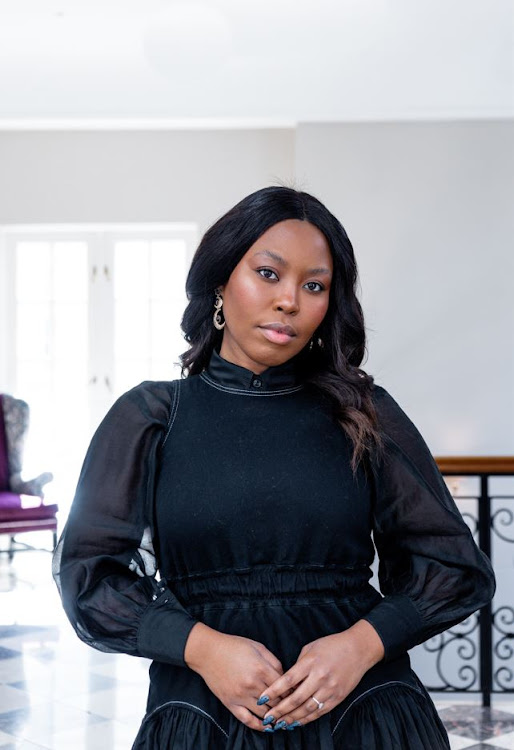Image: Supplied.
I remember the first time my mother noticed that I was going grey. She stopped mid-sentence and, when she found the words, directed her attention to the glittery glint peaking from the crown of my head.
It seems the light had perfectly hit that little patch of grey that I’d become well-acquainted with in the mirror every morning amid my otherwise black, 4C Afro. With a mixture of curiosity and mild concern in her eyes, she asked the question that seemed to have impregnated the air in that moment, “Hawu, are you going grey?”
Yes, I have been for a while now. I’m about to enter my mid-thirties and am well into my silver-streaked era — that little patch of grey that made itself known that day is not the only one. A community of long, silver streaks have made themselves at home in my Afro. At that moment, I could see that our views on greying differed and while, admittedly, there is that slight whip of panic that creeps in when picturing myself with a full head of grey and thinking, “Wow, I’m getting old,” there’s also an excitement and curiosity that makes me embrace my greys like a badge of honour. There’s a beauty there — the beauty and blessing of witnessing your mature years slowly unfold. A big part of that sentiment is due to how the beauty narrative as a whole has changed and been passed down from our grandmothers and mothers to us.
In my years as a beauty editor, I have seen the face of beauty shift and evolve. A couple of years ago, the lack of diversity in the beauty industry was a huge global problem, with Black women not being able to find products for our skin tones. Black was not always beautiful, and nothing was made for us — not foundation shades, not eyeshadow pigments, not sunscreen formulas, not lipstick shades, not haircare products. It almost seemed too much to ask that Black skin be treated with the same respect shown for Western beauty standards.
Only when Rihanna launched Fenty Beauty in 2017 and, with it, the first 40 shades of foundation that we’d seen in our generation, did the status quo start to change. Now a diverse beauty offering is the standard and any brand still operating in the limiting “light, medium, dark” shade spectrum is quickly finding its market share diminishing.
Of course, one could argue that we still have a long way to go in the diversity conversation. It’s no wonder that, for a long time, as Black women, we struggled to fully accept all the incredible features and attributes that make us beautiful. The mirror that has been held up to us has always been a Western one, reflecting back all the things that were wrong or “other” about us.
Even the acceptance of blue-undertoned dark skin has taken time, not only from a global perspective but within Black culture too. Colourism within our own communities has fuelled the exclusivity of the cosmetic industry and given the world permission to not see the full extent of our melanin, hence not providing beauty for all — until we demanded it for ourselves, because all faces of Black beauty deserved a place, platform, and representation in the global beauty narrative.
Growing up, it’s hard to remember seeing ageing beauty being celebrated as it is today. With sayings such as “Black don’t crack,” the idea of ageing, especially in Black culture, wasn’t overtly celebrated, discriminated or worried about. Thanks to the nature of our melanated skin, visible signs of ageing tend not to be as conspicuous as they are on lighter skin tones, making us as Black women appear much younger than we are. In the past, being mature was respected and revered but not really celebrated. You were young and then you were suddenly old and that was that — there wasn’t a playground within the ageing era where that stage of life and the mature beauty that comes with it was enjoyed.
Our grandmothers weren’t ones to pay much attention to greying strands or how they aged: in their era, hair and beauty trends weren’t as popularised as they later became. oGogo would wrap her hair with a scarf or wear hats and berets for the most part, owing to the cultural obligations of being married women and as a sign of respect. They weren’t as fixated on looking a certain way or playing with different beauty aesthetics as we are today, and had simpler means of looking put together and well-dressed in public.
This was in contrast with our parents’ generation, which birthed a variety of hair and beauty trends from the 1960s to 1980s such as the perm, relaxing, hair colouring and Afros. Our mothers’ view of growing older may have had a more emotional shift and reaction when hair got thinner, greys formed or fine wrinkles started to show, as they navigated with no real blueprint of how that stage of beauty should be expressed publicly. Unlike today, when greys are worn loud and proud, back then black hair dye was used to rather cover up greys and keep looking younger for longer.
As a modern generation that fully celebrates grey hair colourways and laugh lines, we have more options, and the unapologetic use of cosmetic surgery and non-invasive skin treatments has become more commonplace. All of this gives us the licence to accept and embrace every stage of life because we know that beauty doesn’t stop at a certain age. Even our mothers are finally in a space to freely embrace their greys and beauty, as a growing global community of silver-fox women pioneer a new face of beauty… allowing women of all ages, skin tones, and sizes to embrace their own beauty journeys in the process.
